Influencing Organizational Strategy: Kodak's Digital Imaging Analysis
VerifiedAdded on 2022/01/04
|23
|5203
|477
Report
AI Summary
This report analyzes Eastman Kodak's digital imaging strategy from 1992 to 2012, examining its core components, including the emphasis on print imaging, external sourcing, harvesting from traditional photography, and managing the transition to digital platforms. The strategy's failure is attributed to several factors: a poor choice of market focus, concentrating on the consumer market and a single part of the value chain, failure to recognize the digital threat early enough, and inadequate financial strategizing. The report includes SWOT and STEEPLE analyses to provide a comprehensive understanding of the internal and external factors influencing Kodak's performance. The company's inability to adapt to disruptive technologies and changing market dynamics ultimately led to its decline, offering valuable lessons for businesses navigating digital transformation and strategic planning. The report emphasizes the importance of recognizing market shifts, financial performance, and the need for a holistic approach to strategy in a competitive digital landscape.
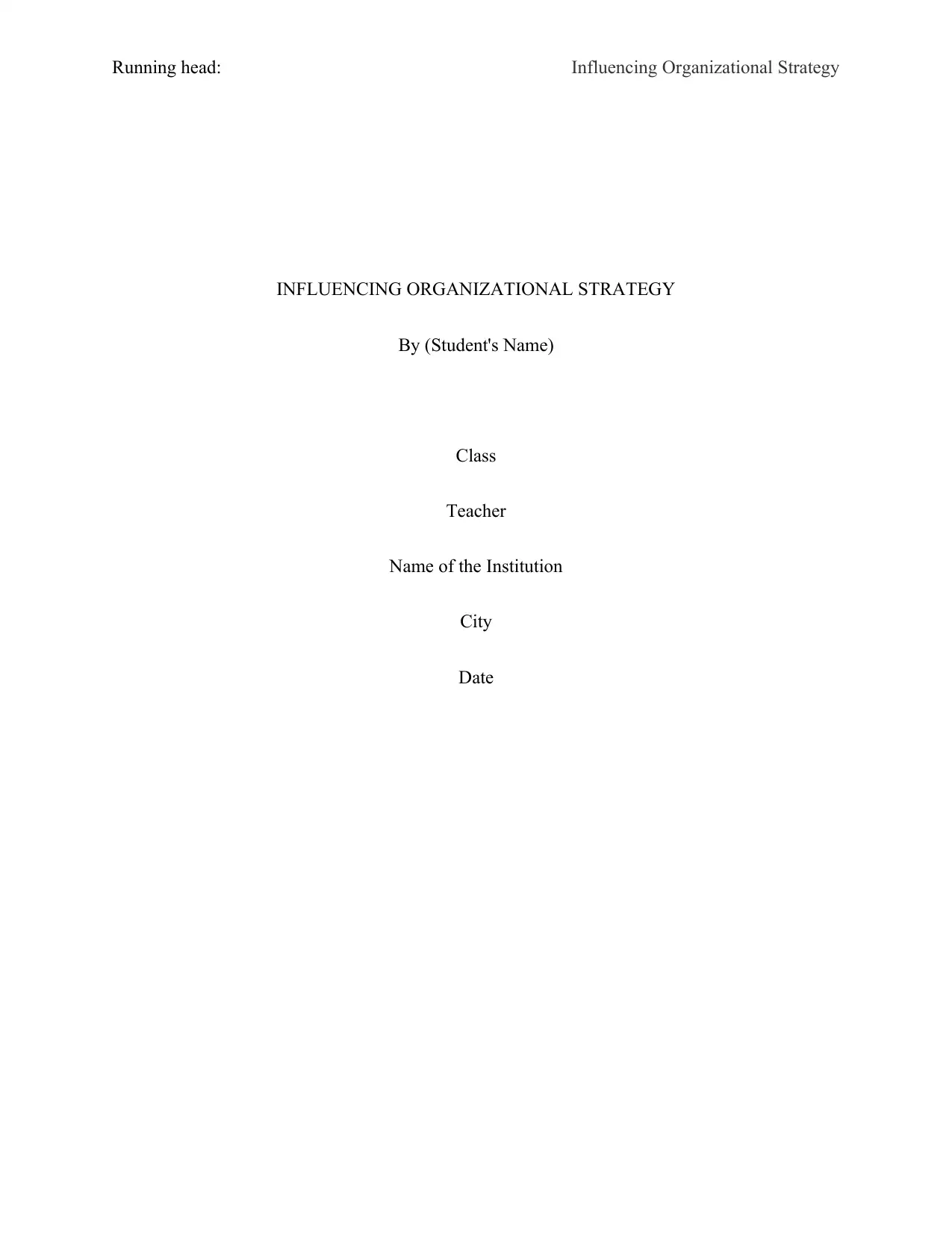
Running head: Influencing Organizational Strategy
INFLUENCING ORGANIZATIONAL STRATEGY
By (Student's Name)
Class
Teacher
Name of the Institution
City
Date
INFLUENCING ORGANIZATIONAL STRATEGY
By (Student's Name)
Class
Teacher
Name of the Institution
City
Date
Paraphrase This Document
Need a fresh take? Get an instant paraphrase of this document with our AI Paraphraser
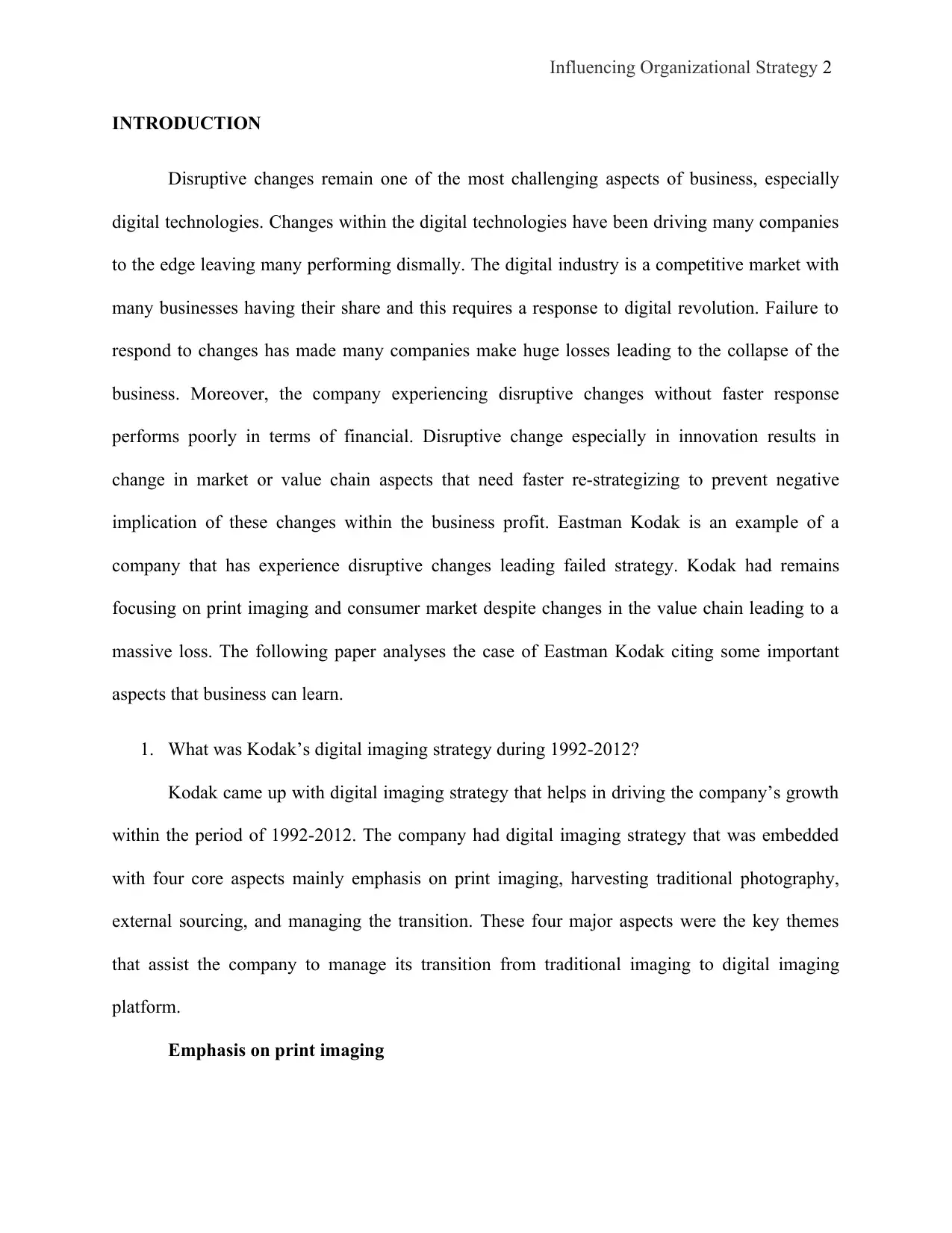
Influencing Organizational Strategy 2
INTRODUCTION
Disruptive changes remain one of the most challenging aspects of business, especially
digital technologies. Changes within the digital technologies have been driving many companies
to the edge leaving many performing dismally. The digital industry is a competitive market with
many businesses having their share and this requires a response to digital revolution. Failure to
respond to changes has made many companies make huge losses leading to the collapse of the
business. Moreover, the company experiencing disruptive changes without faster response
performs poorly in terms of financial. Disruptive change especially in innovation results in
change in market or value chain aspects that need faster re-strategizing to prevent negative
implication of these changes within the business profit. Eastman Kodak is an example of a
company that has experience disruptive changes leading failed strategy. Kodak had remains
focusing on print imaging and consumer market despite changes in the value chain leading to a
massive loss. The following paper analyses the case of Eastman Kodak citing some important
aspects that business can learn.
1. What was Kodak’s digital imaging strategy during 1992-2012?
Kodak came up with digital imaging strategy that helps in driving the company’s growth
within the period of 1992-2012. The company had digital imaging strategy that was embedded
with four core aspects mainly emphasis on print imaging, harvesting traditional photography,
external sourcing, and managing the transition. These four major aspects were the key themes
that assist the company to manage its transition from traditional imaging to digital imaging
platform.
Emphasis on print imaging
INTRODUCTION
Disruptive changes remain one of the most challenging aspects of business, especially
digital technologies. Changes within the digital technologies have been driving many companies
to the edge leaving many performing dismally. The digital industry is a competitive market with
many businesses having their share and this requires a response to digital revolution. Failure to
respond to changes has made many companies make huge losses leading to the collapse of the
business. Moreover, the company experiencing disruptive changes without faster response
performs poorly in terms of financial. Disruptive change especially in innovation results in
change in market or value chain aspects that need faster re-strategizing to prevent negative
implication of these changes within the business profit. Eastman Kodak is an example of a
company that has experience disruptive changes leading failed strategy. Kodak had remains
focusing on print imaging and consumer market despite changes in the value chain leading to a
massive loss. The following paper analyses the case of Eastman Kodak citing some important
aspects that business can learn.
1. What was Kodak’s digital imaging strategy during 1992-2012?
Kodak came up with digital imaging strategy that helps in driving the company’s growth
within the period of 1992-2012. The company had digital imaging strategy that was embedded
with four core aspects mainly emphasis on print imaging, harvesting traditional photography,
external sourcing, and managing the transition. These four major aspects were the key themes
that assist the company to manage its transition from traditional imaging to digital imaging
platform.
Emphasis on print imaging
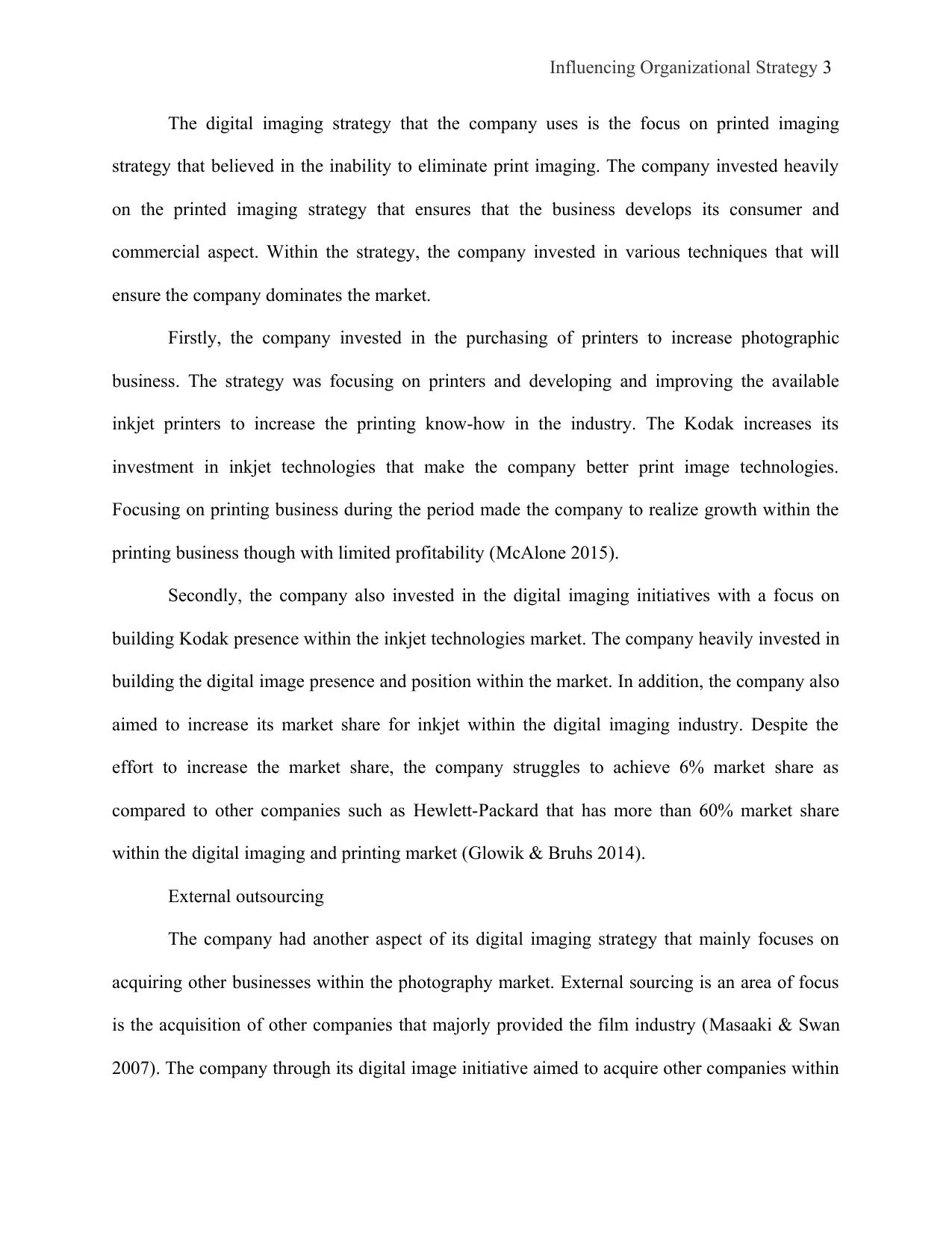
Influencing Organizational Strategy 3
The digital imaging strategy that the company uses is the focus on printed imaging
strategy that believed in the inability to eliminate print imaging. The company invested heavily
on the printed imaging strategy that ensures that the business develops its consumer and
commercial aspect. Within the strategy, the company invested in various techniques that will
ensure the company dominates the market.
Firstly, the company invested in the purchasing of printers to increase photographic
business. The strategy was focusing on printers and developing and improving the available
inkjet printers to increase the printing know-how in the industry. The Kodak increases its
investment in inkjet technologies that make the company better print image technologies.
Focusing on printing business during the period made the company to realize growth within the
printing business though with limited profitability (McAlone 2015).
Secondly, the company also invested in the digital imaging initiatives with a focus on
building Kodak presence within the inkjet technologies market. The company heavily invested in
building the digital image presence and position within the market. In addition, the company also
aimed to increase its market share for inkjet within the digital imaging industry. Despite the
effort to increase the market share, the company struggles to achieve 6% market share as
compared to other companies such as Hewlett-Packard that has more than 60% market share
within the digital imaging and printing market (Glowik & Bruhs 2014).
External outsourcing
The company had another aspect of its digital imaging strategy that mainly focuses on
acquiring other businesses within the photography market. External sourcing is an area of focus
is the acquisition of other companies that majorly provided the film industry (Masaaki & Swan
2007). The company through its digital image initiative aimed to acquire other companies within
The digital imaging strategy that the company uses is the focus on printed imaging
strategy that believed in the inability to eliminate print imaging. The company invested heavily
on the printed imaging strategy that ensures that the business develops its consumer and
commercial aspect. Within the strategy, the company invested in various techniques that will
ensure the company dominates the market.
Firstly, the company invested in the purchasing of printers to increase photographic
business. The strategy was focusing on printers and developing and improving the available
inkjet printers to increase the printing know-how in the industry. The Kodak increases its
investment in inkjet technologies that make the company better print image technologies.
Focusing on printing business during the period made the company to realize growth within the
printing business though with limited profitability (McAlone 2015).
Secondly, the company also invested in the digital imaging initiatives with a focus on
building Kodak presence within the inkjet technologies market. The company heavily invested in
building the digital image presence and position within the market. In addition, the company also
aimed to increase its market share for inkjet within the digital imaging industry. Despite the
effort to increase the market share, the company struggles to achieve 6% market share as
compared to other companies such as Hewlett-Packard that has more than 60% market share
within the digital imaging and printing market (Glowik & Bruhs 2014).
External outsourcing
The company had another aspect of its digital imaging strategy that mainly focuses on
acquiring other businesses within the photography market. External sourcing is an area of focus
is the acquisition of other companies that majorly provided the film industry (Masaaki & Swan
2007). The company through its digital image initiative aimed to acquire other companies within
⊘ This is a preview!⊘
Do you want full access?
Subscribe today to unlock all pages.

Trusted by 1+ million students worldwide

Influencing Organizational Strategy 4
the market to increase its share. Failure to perform within the market ensures that the company
reduces its involvement within the photographic market as it continues to make loss leading to
total withdrawal. This made the company to cut jobs within the company and it also reduces the
film products (Baaken & Teczke 2014).
Harvesting from traditional photography
Kodak increases its investment within the traditional photography portfolio to ensure that
harvesting from the business. The company had indicated that despite the transition to digital
business the company will remain and increase its dominance within the traditional photography
market. The company also acquire other companies within the photography market to ensure its
increase its film investment and this reduces its chance of other business (Sandström 2010).
Managing transition
The Kodak forms a key pillar of its digital market strategy that would help in managing
the transition into digital imaging innovation. The company, therefore, devised the approaches
that can be used to manage the transition. The market approaches to transition include the
consumer-oriented market, professional and commercial market. With these approaches, only the
consumer market was already in operation leading to a concentration on a single part of the value
chain. This aspect of the strategy focuses on simplicity and quality market approach to ensure
the company remains within the market leadership (Numssen 2012).
2. Why did the strategy fail?
The Kodak had a vision of becoming a market leader within the digital image and
photography industry. The approach of the company or its strategy failed to materialize
especially due to much financial poor performance that was realized by the company CEO Perez.
the market to increase its share. Failure to perform within the market ensures that the company
reduces its involvement within the photographic market as it continues to make loss leading to
total withdrawal. This made the company to cut jobs within the company and it also reduces the
film products (Baaken & Teczke 2014).
Harvesting from traditional photography
Kodak increases its investment within the traditional photography portfolio to ensure that
harvesting from the business. The company had indicated that despite the transition to digital
business the company will remain and increase its dominance within the traditional photography
market. The company also acquire other companies within the photography market to ensure its
increase its film investment and this reduces its chance of other business (Sandström 2010).
Managing transition
The Kodak forms a key pillar of its digital market strategy that would help in managing
the transition into digital imaging innovation. The company, therefore, devised the approaches
that can be used to manage the transition. The market approaches to transition include the
consumer-oriented market, professional and commercial market. With these approaches, only the
consumer market was already in operation leading to a concentration on a single part of the value
chain. This aspect of the strategy focuses on simplicity and quality market approach to ensure
the company remains within the market leadership (Numssen 2012).
2. Why did the strategy fail?
The Kodak had a vision of becoming a market leader within the digital image and
photography industry. The approach of the company or its strategy failed to materialize
especially due to much financial poor performance that was realized by the company CEO Perez.
Paraphrase This Document
Need a fresh take? Get an instant paraphrase of this document with our AI Paraphraser
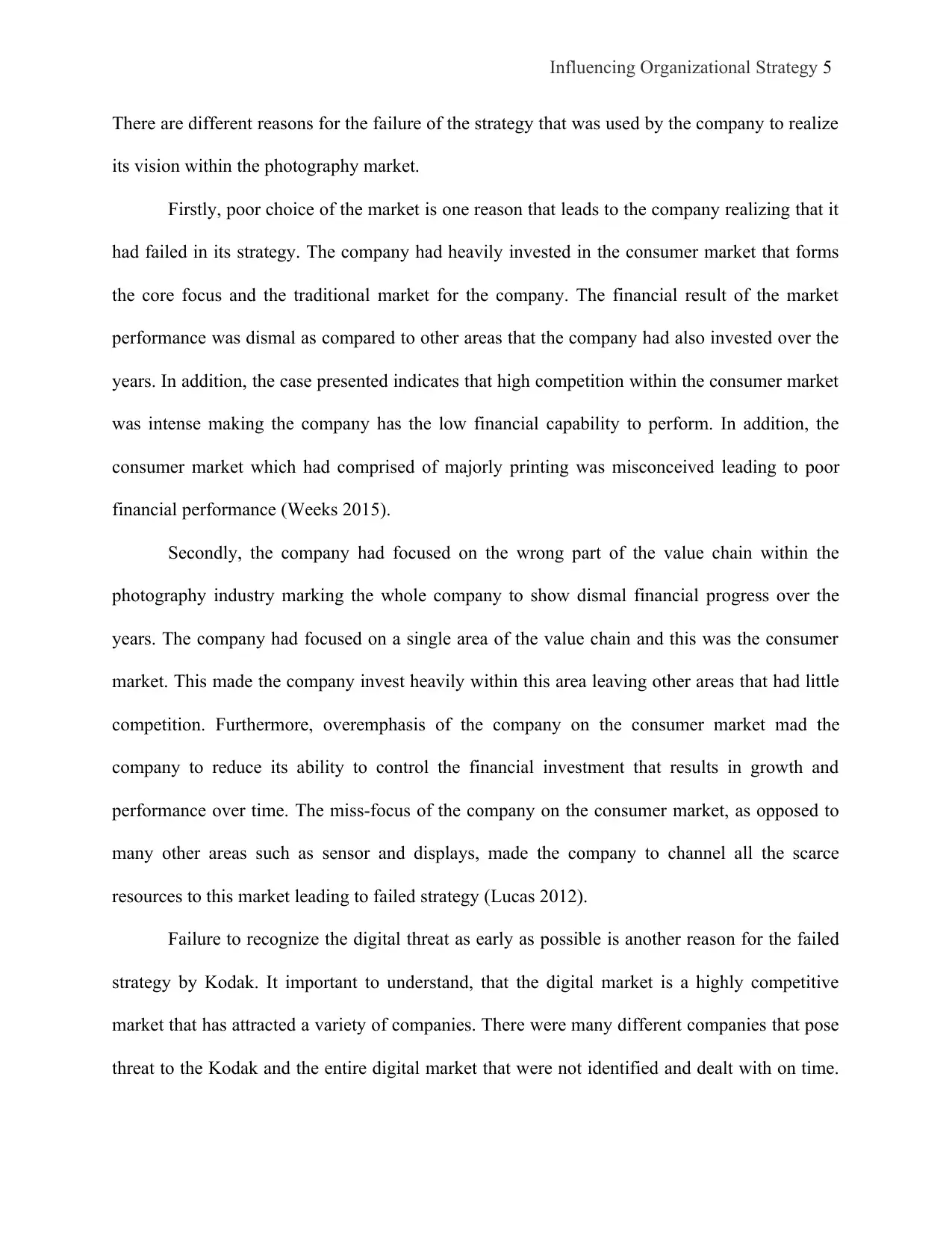
Influencing Organizational Strategy 5
There are different reasons for the failure of the strategy that was used by the company to realize
its vision within the photography market.
Firstly, poor choice of the market is one reason that leads to the company realizing that it
had failed in its strategy. The company had heavily invested in the consumer market that forms
the core focus and the traditional market for the company. The financial result of the market
performance was dismal as compared to other areas that the company had also invested over the
years. In addition, the case presented indicates that high competition within the consumer market
was intense making the company has the low financial capability to perform. In addition, the
consumer market which had comprised of majorly printing was misconceived leading to poor
financial performance (Weeks 2015).
Secondly, the company had focused on the wrong part of the value chain within the
photography industry marking the whole company to show dismal financial progress over the
years. The company had focused on a single area of the value chain and this was the consumer
market. This made the company invest heavily within this area leaving other areas that had little
competition. Furthermore, overemphasis of the company on the consumer market mad the
company to reduce its ability to control the financial investment that results in growth and
performance over time. The miss-focus of the company on the consumer market, as opposed to
many other areas such as sensor and displays, made the company to channel all the scarce
resources to this market leading to failed strategy (Lucas 2012).
Failure to recognize the digital threat as early as possible is another reason for the failed
strategy by Kodak. It important to understand, that the digital market is a highly competitive
market that has attracted a variety of companies. There were many different companies that pose
threat to the Kodak and the entire digital market that were not identified and dealt with on time.
There are different reasons for the failure of the strategy that was used by the company to realize
its vision within the photography market.
Firstly, poor choice of the market is one reason that leads to the company realizing that it
had failed in its strategy. The company had heavily invested in the consumer market that forms
the core focus and the traditional market for the company. The financial result of the market
performance was dismal as compared to other areas that the company had also invested over the
years. In addition, the case presented indicates that high competition within the consumer market
was intense making the company has the low financial capability to perform. In addition, the
consumer market which had comprised of majorly printing was misconceived leading to poor
financial performance (Weeks 2015).
Secondly, the company had focused on the wrong part of the value chain within the
photography industry marking the whole company to show dismal financial progress over the
years. The company had focused on a single area of the value chain and this was the consumer
market. This made the company invest heavily within this area leaving other areas that had little
competition. Furthermore, overemphasis of the company on the consumer market mad the
company to reduce its ability to control the financial investment that results in growth and
performance over time. The miss-focus of the company on the consumer market, as opposed to
many other areas such as sensor and displays, made the company to channel all the scarce
resources to this market leading to failed strategy (Lucas 2012).
Failure to recognize the digital threat as early as possible is another reason for the failed
strategy by Kodak. It important to understand, that the digital market is a highly competitive
market that has attracted a variety of companies. There were many different companies that pose
threat to the Kodak and the entire digital market that were not identified and dealt with on time.
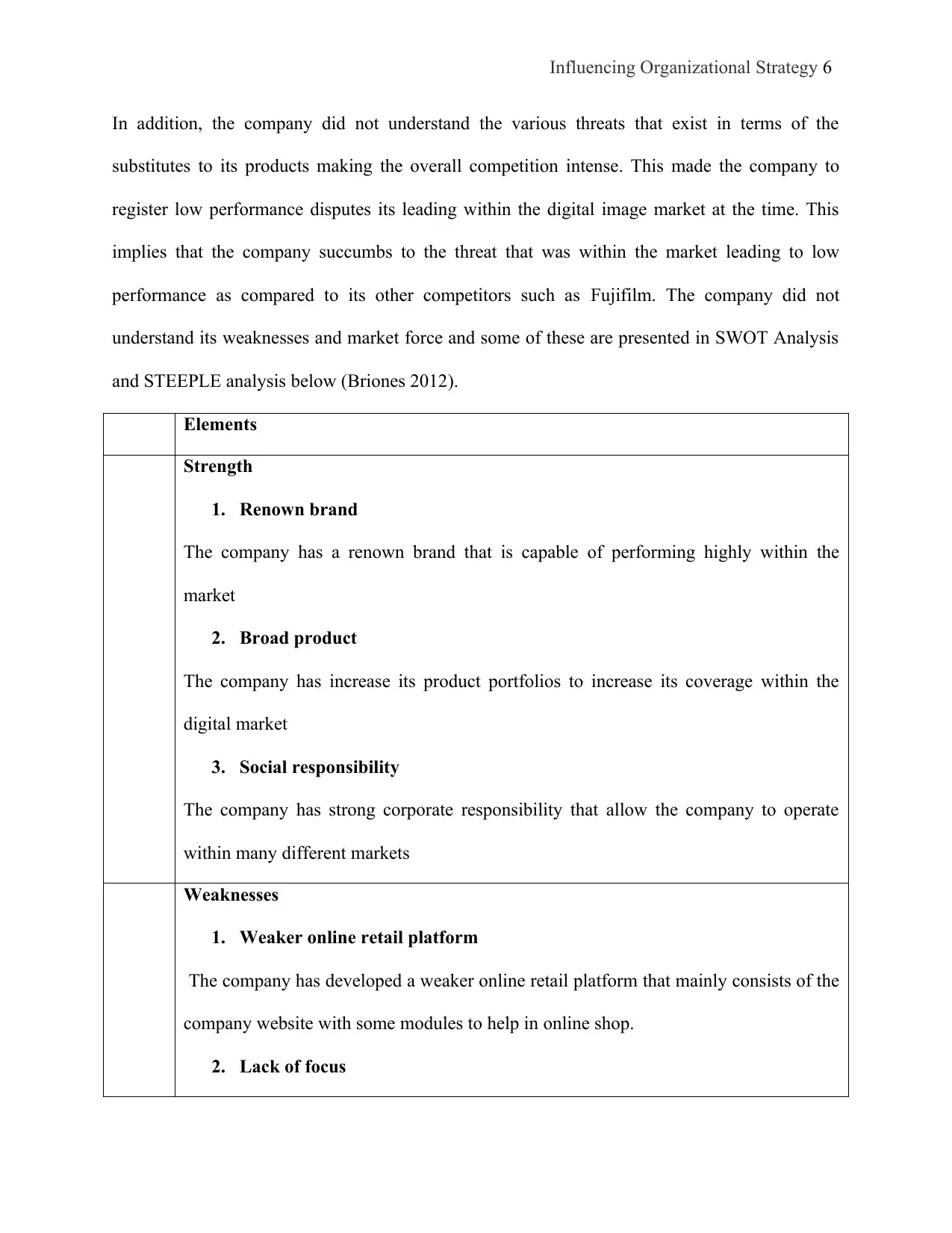
Influencing Organizational Strategy 6
In addition, the company did not understand the various threats that exist in terms of the
substitutes to its products making the overall competition intense. This made the company to
register low performance disputes its leading within the digital image market at the time. This
implies that the company succumbs to the threat that was within the market leading to low
performance as compared to its other competitors such as Fujifilm. The company did not
understand its weaknesses and market force and some of these are presented in SWOT Analysis
and STEEPLE analysis below (Briones 2012).
Elements
Strength
1. Renown brand
The company has a renown brand that is capable of performing highly within the
market
2. Broad product
The company has increase its product portfolios to increase its coverage within the
digital market
3. Social responsibility
The company has strong corporate responsibility that allow the company to operate
within many different markets
Weaknesses
1. Weaker online retail platform
The company has developed a weaker online retail platform that mainly consists of the
company website with some modules to help in online shop.
2. Lack of focus
In addition, the company did not understand the various threats that exist in terms of the
substitutes to its products making the overall competition intense. This made the company to
register low performance disputes its leading within the digital image market at the time. This
implies that the company succumbs to the threat that was within the market leading to low
performance as compared to its other competitors such as Fujifilm. The company did not
understand its weaknesses and market force and some of these are presented in SWOT Analysis
and STEEPLE analysis below (Briones 2012).
Elements
Strength
1. Renown brand
The company has a renown brand that is capable of performing highly within the
market
2. Broad product
The company has increase its product portfolios to increase its coverage within the
digital market
3. Social responsibility
The company has strong corporate responsibility that allow the company to operate
within many different markets
Weaknesses
1. Weaker online retail platform
The company has developed a weaker online retail platform that mainly consists of the
company website with some modules to help in online shop.
2. Lack of focus
⊘ This is a preview!⊘
Do you want full access?
Subscribe today to unlock all pages.

Trusted by 1+ million students worldwide
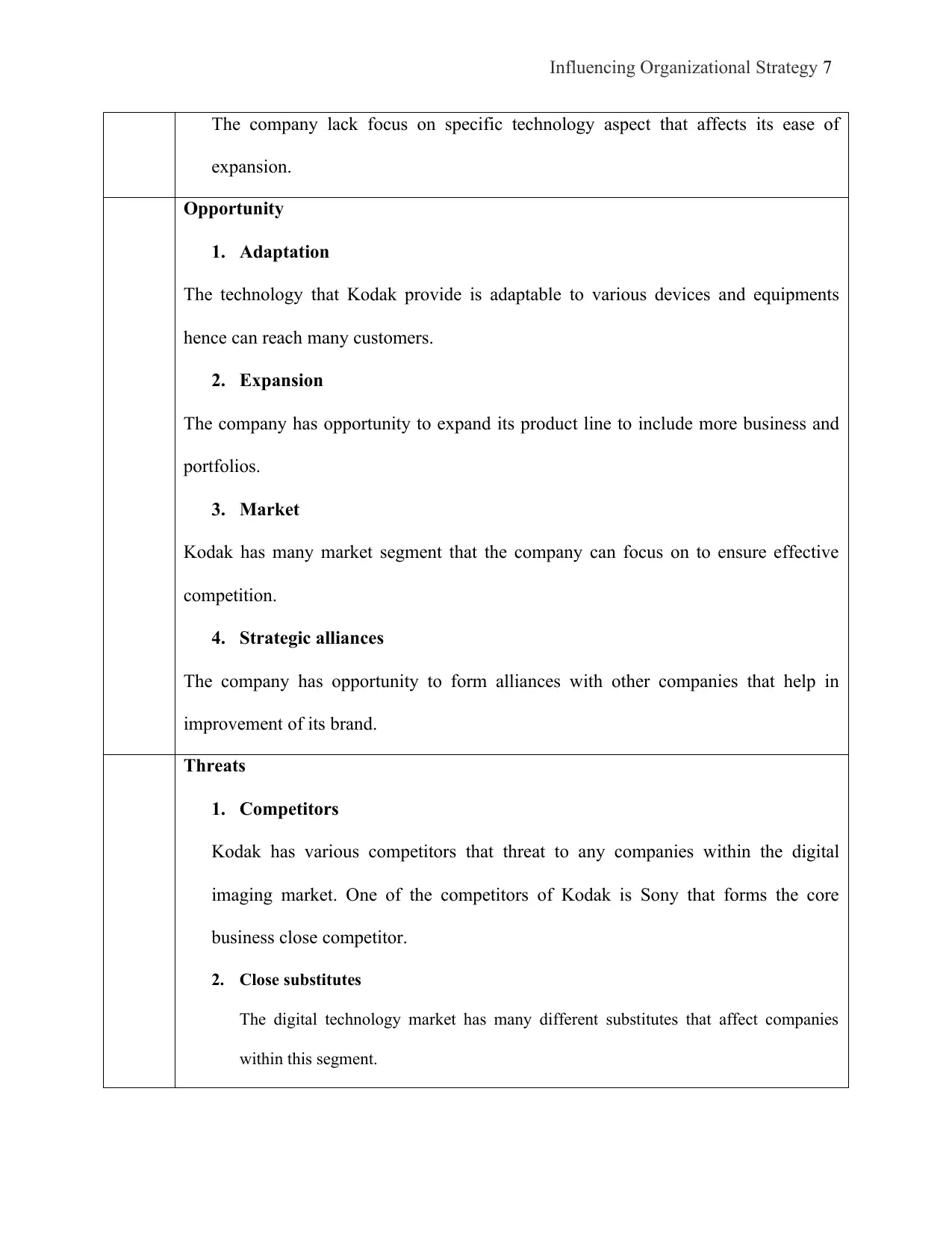
Influencing Organizational Strategy 7
The company lack focus on specific technology aspect that affects its ease of
expansion.
Opportunity
1. Adaptation
The technology that Kodak provide is adaptable to various devices and equipments
hence can reach many customers.
2. Expansion
The company has opportunity to expand its product line to include more business and
portfolios.
3. Market
Kodak has many market segment that the company can focus on to ensure effective
competition.
4. Strategic alliances
The company has opportunity to form alliances with other companies that help in
improvement of its brand.
Threats
1. Competitors
Kodak has various competitors that threat to any companies within the digital
imaging market. One of the competitors of Kodak is Sony that forms the core
business close competitor.
2. Close substitutes
The digital technology market has many different substitutes that affect companies
within this segment.
The company lack focus on specific technology aspect that affects its ease of
expansion.
Opportunity
1. Adaptation
The technology that Kodak provide is adaptable to various devices and equipments
hence can reach many customers.
2. Expansion
The company has opportunity to expand its product line to include more business and
portfolios.
3. Market
Kodak has many market segment that the company can focus on to ensure effective
competition.
4. Strategic alliances
The company has opportunity to form alliances with other companies that help in
improvement of its brand.
Threats
1. Competitors
Kodak has various competitors that threat to any companies within the digital
imaging market. One of the competitors of Kodak is Sony that forms the core
business close competitor.
2. Close substitutes
The digital technology market has many different substitutes that affect companies
within this segment.
Paraphrase This Document
Need a fresh take? Get an instant paraphrase of this document with our AI Paraphraser

Influencing Organizational Strategy 8
3. Buyers power
Buyers control many businesses as they can make purchase based on their wiliness to
purchase.
STEEP Analysis
Social
Society’s culture and way of doing things impact the culture of an organization in an
environment. Changes in customers’ needs and preferences for high-tech imaging products and
changing life styles has increased the pace of organizational change in Kodak in-terms of
meeting these needs
Entrepreneurial spirit and broader nature of the society. Some societies encourage
entrepreneurship while some don’t.
Education level as well as education standard in the Eastman Kodak Company ’s digital market
Technological
The evolution of technologies within the digital market is affecting the operation of
Kodak. Some of the technological factors include Recent technological developments by
Eastman Kodak Company competitors
The Impact on cost structure in Electronic Equipment industry
Impact on value chain structure in Consumer Goods sector
Economic
The Macro environment factors such as – inflation rate, savings rate, interest rate, foreign
exchange rate and economic cycle determine the aggregate demand and aggregate investment in
an economy.
Ecological
3. Buyers power
Buyers control many businesses as they can make purchase based on their wiliness to
purchase.
STEEP Analysis
Social
Society’s culture and way of doing things impact the culture of an organization in an
environment. Changes in customers’ needs and preferences for high-tech imaging products and
changing life styles has increased the pace of organizational change in Kodak in-terms of
meeting these needs
Entrepreneurial spirit and broader nature of the society. Some societies encourage
entrepreneurship while some don’t.
Education level as well as education standard in the Eastman Kodak Company ’s digital market
Technological
The evolution of technologies within the digital market is affecting the operation of
Kodak. Some of the technological factors include Recent technological developments by
Eastman Kodak Company competitors
The Impact on cost structure in Electronic Equipment industry
Impact on value chain structure in Consumer Goods sector
Economic
The Macro environment factors such as – inflation rate, savings rate, interest rate, foreign
exchange rate and economic cycle determine the aggregate demand and aggregate investment in
an economy.
Ecological

Influencing Organizational Strategy 9
There are environmental standards and laws which can impact the profitability of an
organization in those markets. Some of these include Laws regulating environment
pollution, Air and water pollution regulations in Electronic Equipment industry
Recycling
Political
Political stability and importance of Electronic Equipment sector in the country's economy play
an important role in performance of Kodak.
Industrial safety regulations in the Consumer Goods sector are another political factor that
affects operation of Kodak.
Legal
Some of the legal factors that Eastman Kodak Company leadership should consider while
entering a new market is legal factors controlling. Some of the laws that affects Kodak operation
include
Copyright, patents / Intellectual property law
Consumer protection and e-commerce
Employment law
Health and safety law
Data Protection
Ethics
The market where Kodak operates requires high ethical conducts that is couple with honesty,
There are environmental standards and laws which can impact the profitability of an
organization in those markets. Some of these include Laws regulating environment
pollution, Air and water pollution regulations in Electronic Equipment industry
Recycling
Political
Political stability and importance of Electronic Equipment sector in the country's economy play
an important role in performance of Kodak.
Industrial safety regulations in the Consumer Goods sector are another political factor that
affects operation of Kodak.
Legal
Some of the legal factors that Eastman Kodak Company leadership should consider while
entering a new market is legal factors controlling. Some of the laws that affects Kodak operation
include
Copyright, patents / Intellectual property law
Consumer protection and e-commerce
Employment law
Health and safety law
Data Protection
Ethics
The market where Kodak operates requires high ethical conducts that is couple with honesty,
⊘ This is a preview!⊘
Do you want full access?
Subscribe today to unlock all pages.

Trusted by 1+ million students worldwide
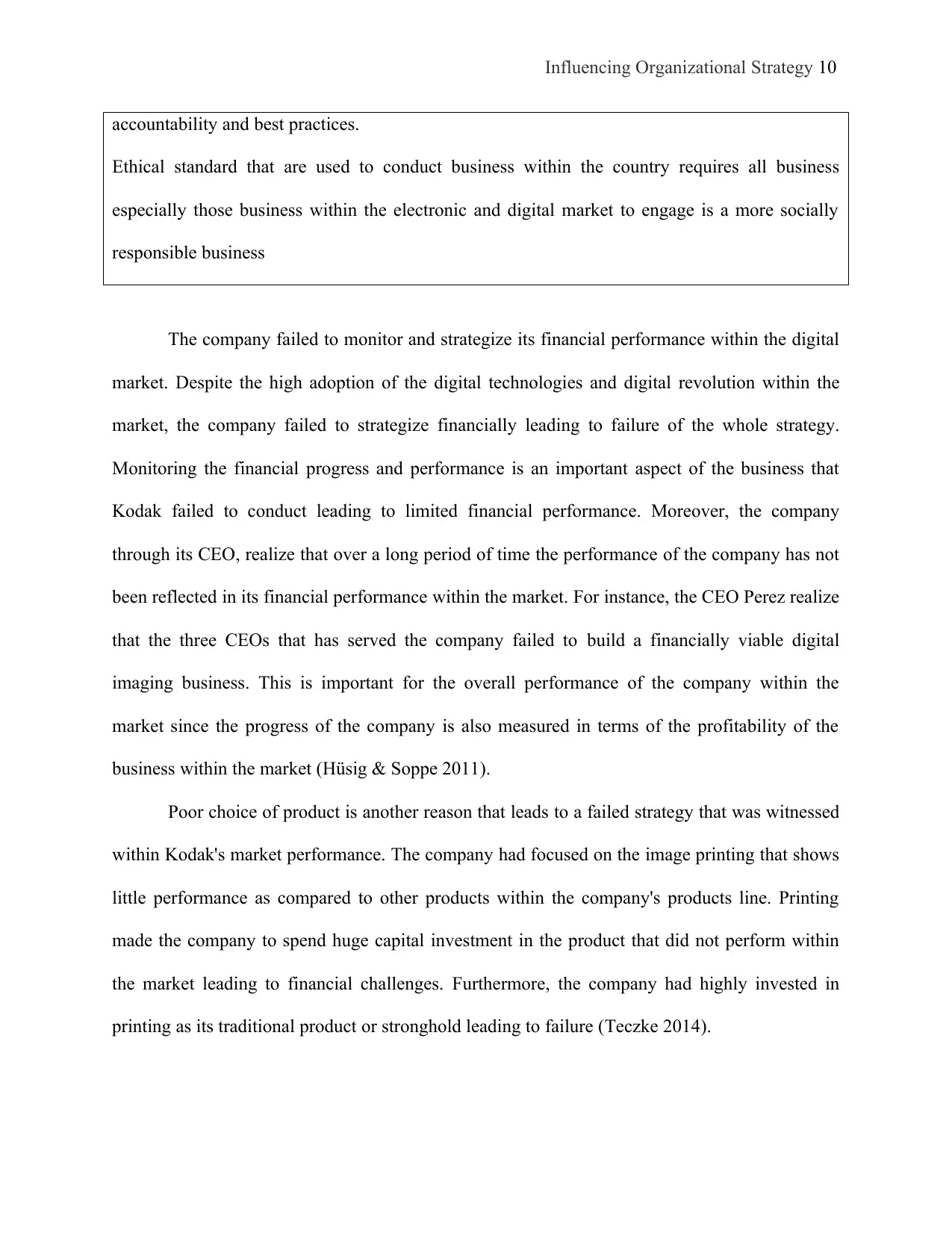
Influencing Organizational Strategy 10
accountability and best practices.
Ethical standard that are used to conduct business within the country requires all business
especially those business within the electronic and digital market to engage is a more socially
responsible business
The company failed to monitor and strategize its financial performance within the digital
market. Despite the high adoption of the digital technologies and digital revolution within the
market, the company failed to strategize financially leading to failure of the whole strategy.
Monitoring the financial progress and performance is an important aspect of the business that
Kodak failed to conduct leading to limited financial performance. Moreover, the company
through its CEO, realize that over a long period of time the performance of the company has not
been reflected in its financial performance within the market. For instance, the CEO Perez realize
that the three CEOs that has served the company failed to build a financially viable digital
imaging business. This is important for the overall performance of the company within the
market since the progress of the company is also measured in terms of the profitability of the
business within the market (Hüsig & Soppe 2011).
Poor choice of product is another reason that leads to a failed strategy that was witnessed
within Kodak's market performance. The company had focused on the image printing that shows
little performance as compared to other products within the company's products line. Printing
made the company to spend huge capital investment in the product that did not perform within
the market leading to financial challenges. Furthermore, the company had highly invested in
printing as its traditional product or stronghold leading to failure (Teczke 2014).
accountability and best practices.
Ethical standard that are used to conduct business within the country requires all business
especially those business within the electronic and digital market to engage is a more socially
responsible business
The company failed to monitor and strategize its financial performance within the digital
market. Despite the high adoption of the digital technologies and digital revolution within the
market, the company failed to strategize financially leading to failure of the whole strategy.
Monitoring the financial progress and performance is an important aspect of the business that
Kodak failed to conduct leading to limited financial performance. Moreover, the company
through its CEO, realize that over a long period of time the performance of the company has not
been reflected in its financial performance within the market. For instance, the CEO Perez realize
that the three CEOs that has served the company failed to build a financially viable digital
imaging business. This is important for the overall performance of the company within the
market since the progress of the company is also measured in terms of the profitability of the
business within the market (Hüsig & Soppe 2011).
Poor choice of product is another reason that leads to a failed strategy that was witnessed
within Kodak's market performance. The company had focused on the image printing that shows
little performance as compared to other products within the company's products line. Printing
made the company to spend huge capital investment in the product that did not perform within
the market leading to financial challenges. Furthermore, the company had highly invested in
printing as its traditional product or stronghold leading to failure (Teczke 2014).
Paraphrase This Document
Need a fresh take? Get an instant paraphrase of this document with our AI Paraphraser

Influencing Organizational Strategy 11
Kodak also prioritizes on areas that were non-existence such as "infoimaging" industry
that ensures high spending leading to financial challenges. The company had indicated its vision
of becoming a leader in "infoimaging" within the industry, a portfolio that never existed in the
first place. This implies that the company had intended to invest in areas that were not initially
strategized for and the financial feasibility of the area was in doubt. As the strategy continues to
stager, the company has to reconsider becoming a market leader in "infoimaging" leading to poor
financial strategy. Moreover, the company did not understand its business environment so as to
act according and the analysis of PESTLE show the market situation as shown below (Durantin,
Fanmuy, Miet & Pegon 2017).
Pestle analysis of Kodak
Political
Political stability and importance of Electronic Equipment sector in the country's economy play
an important role in performance of Kodak.
Industrial safety regulations in the Consumer Goods sector are another political factor that
affects operation of Kodak.
Economic
The Macro environment factors such as – inflation rate, savings rate, interest rate, foreign
exchange rate and economic cycle determine the aggregate demand and aggregate investment in
an economy.
Efficiency of financial markets – Does Eastman Kodak Company needs to raise capital in local
market
Social
Kodak also prioritizes on areas that were non-existence such as "infoimaging" industry
that ensures high spending leading to financial challenges. The company had indicated its vision
of becoming a leader in "infoimaging" within the industry, a portfolio that never existed in the
first place. This implies that the company had intended to invest in areas that were not initially
strategized for and the financial feasibility of the area was in doubt. As the strategy continues to
stager, the company has to reconsider becoming a market leader in "infoimaging" leading to poor
financial strategy. Moreover, the company did not understand its business environment so as to
act according and the analysis of PESTLE show the market situation as shown below (Durantin,
Fanmuy, Miet & Pegon 2017).
Pestle analysis of Kodak
Political
Political stability and importance of Electronic Equipment sector in the country's economy play
an important role in performance of Kodak.
Industrial safety regulations in the Consumer Goods sector are another political factor that
affects operation of Kodak.
Economic
The Macro environment factors such as – inflation rate, savings rate, interest rate, foreign
exchange rate and economic cycle determine the aggregate demand and aggregate investment in
an economy.
Efficiency of financial markets – Does Eastman Kodak Company needs to raise capital in local
market
Social
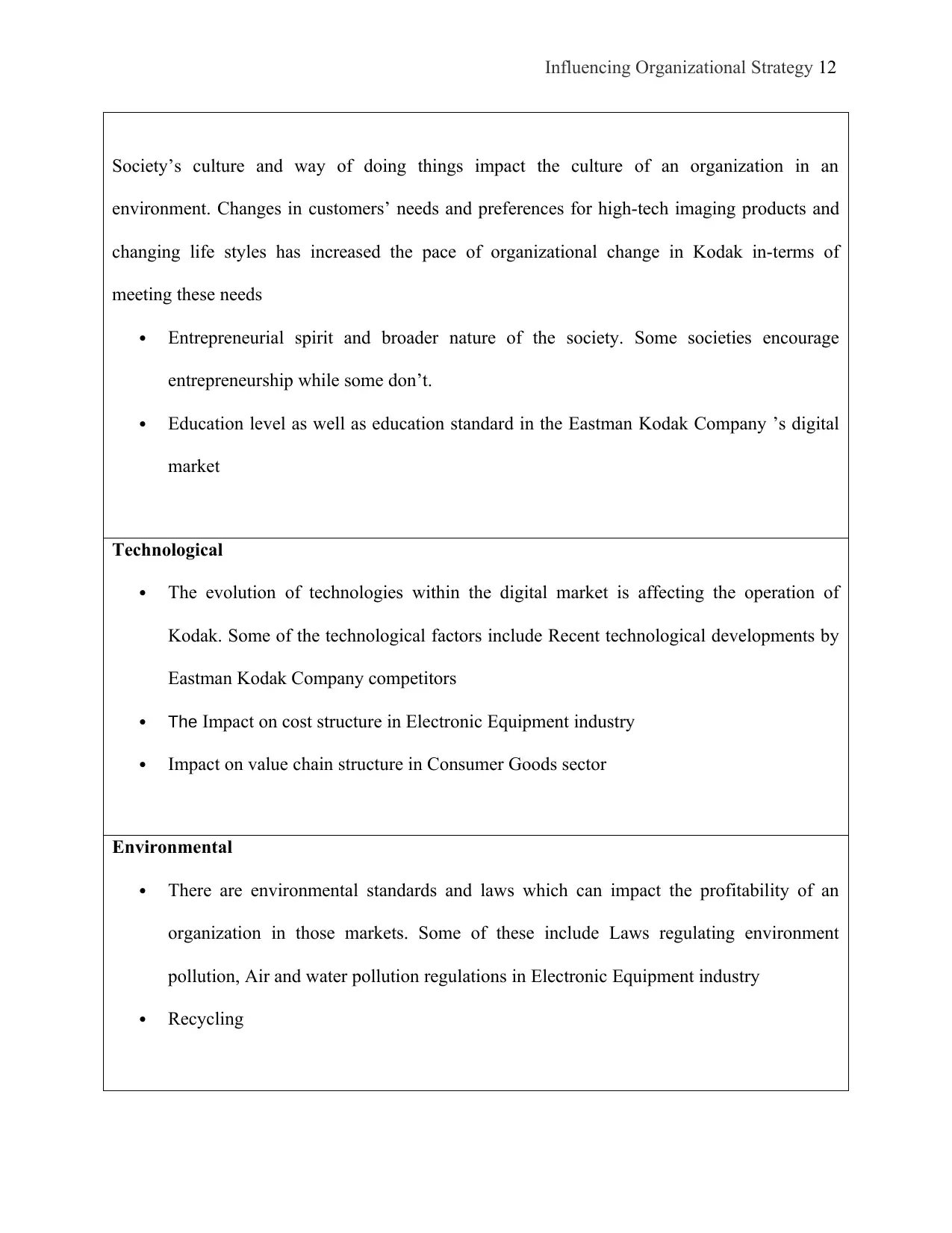
Influencing Organizational Strategy 12
Society’s culture and way of doing things impact the culture of an organization in an
environment. Changes in customers’ needs and preferences for high-tech imaging products and
changing life styles has increased the pace of organizational change in Kodak in-terms of
meeting these needs
Entrepreneurial spirit and broader nature of the society. Some societies encourage
entrepreneurship while some don’t.
Education level as well as education standard in the Eastman Kodak Company ’s digital
market
Technological
The evolution of technologies within the digital market is affecting the operation of
Kodak. Some of the technological factors include Recent technological developments by
Eastman Kodak Company competitors
The Impact on cost structure in Electronic Equipment industry
Impact on value chain structure in Consumer Goods sector
Environmental
There are environmental standards and laws which can impact the profitability of an
organization in those markets. Some of these include Laws regulating environment
pollution, Air and water pollution regulations in Electronic Equipment industry
Recycling
Society’s culture and way of doing things impact the culture of an organization in an
environment. Changes in customers’ needs and preferences for high-tech imaging products and
changing life styles has increased the pace of organizational change in Kodak in-terms of
meeting these needs
Entrepreneurial spirit and broader nature of the society. Some societies encourage
entrepreneurship while some don’t.
Education level as well as education standard in the Eastman Kodak Company ’s digital
market
Technological
The evolution of technologies within the digital market is affecting the operation of
Kodak. Some of the technological factors include Recent technological developments by
Eastman Kodak Company competitors
The Impact on cost structure in Electronic Equipment industry
Impact on value chain structure in Consumer Goods sector
Environmental
There are environmental standards and laws which can impact the profitability of an
organization in those markets. Some of these include Laws regulating environment
pollution, Air and water pollution regulations in Electronic Equipment industry
Recycling
⊘ This is a preview!⊘
Do you want full access?
Subscribe today to unlock all pages.

Trusted by 1+ million students worldwide
1 out of 23
Related Documents
Your All-in-One AI-Powered Toolkit for Academic Success.
+13062052269
info@desklib.com
Available 24*7 on WhatsApp / Email
![[object Object]](/_next/static/media/star-bottom.7253800d.svg)
Unlock your academic potential
Copyright © 2020–2026 A2Z Services. All Rights Reserved. Developed and managed by ZUCOL.





